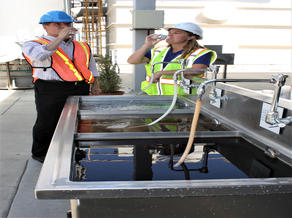Whether by nature or science, all water is recycled water. In large areas of Orange County, much of the water is recycled through science, allowing residents to have a more sustainable water supply.
At the Orange County Water District (OCWD), located in Fountain Valley, something new is happening.
The District is approved to bottle and distribute recycled water for demonstration purposes. The water is purified to state and federal drinking water standards.
“AB 2022 passed in September 2016, and became effective January 1, 2017,” said James Vanderbilt, OCWD board member and City of Anaheim Council Member. “This bill permits public utilities to bottle purified re-used water. We are the only agency in the western hemisphere to receive approval.”
“Water is collected from showers, sinks, toilets, laundry, and dishwashers,” said Sandy Scott-Roberts, P.E., Groundwater Replenishment System Program Manager. “The Orange County Sanitation District puts the water through two cleaning processes, then we purify it through three more processes before putting it into the groundwater basin.”
The purifying removes human and animal waste products, pharmaceuticals, chemicals, and anything else that is not pure water. Purifying processes include: microfiltration, reverse osmosis, and UV advanced oxidation, then it is sent to the groundwater basin.
“The groundwater basin is used like a storage tank. It is a natural filter using sand,” Scott-Roberts continued. “The water moves through the basin with a travel time of two months.”
At this point, a total of 19 cities and water agencies collect the water from the basin, and may add chlorine, fluoride, and other substances before it is delivered to the consumer. Areas supplied with this water are outlined on the OCWD website, but, in general, include: Anaheim, Buena Park, Fullerton, Cypress, Stanton,Westminster, Orange, Santa Ana, Tustin, Fountain Valley, Huntington Beach, Costa Mesa, and Irvine.
The new bottling program, approved in 2016, allows OCWD to collect some of the purified water before it goes into the groundwater basin, and bottle it. They may then distribute the bottled water at community events, street fairs, conferences and other places to demonstrate the quality of the recycled water.
Water in Orange County comes from three sources: rainfall, Santa Ana River, and the groundwater replenishment system which uses recycled water. Rainwater is diverted from the Santa Ana River to replenishment basins for treatment.
The Prado Dam, built by the U.S. Army Corps of Engineers, holds seven billion gallons of water, which is stored until ready for recharging. When it gets too full, water is released into the river to go to the Pacific Ocean.
“We can’t capture it from the Santa Ana River during a release since the water is traveling too fast,” said Scott-Roberts. “That water is lost.”
“Since 2006, we have been in a depletion trend due to the drought. We are now on an upward trend. Our storage was at 40% in January, but the recent rains have helped it increase,” said Scott-Roberts. “The board just voted to add a surplus of 22,000 acre feet of additional water. We are being proactive.”
“This has been a huge learning curve,” said Vanderbilt, who joined the board in January. “We live in a desert; everyone wants to live here. We need to manage growth and be inventive.”
“This facility is a popular field trip location,” shared Scott-Roberts. “We get nursing students, science classes and classrooms.”
One of the most important issues that faced the agency was how to prevent seawater intrusion to the groundwater replenishment basin.
Since the 1970s, an innovative system creates a water wall to block the seawater contamination of the basin.
Constant monitoring of the basin, treatment facility, water sampling and more, keeps the drinking-water quality consistent. Should monitoring equipment find problems outside normal levels, the processing shuts down completely until analysis can be conducted and corrections made.
One time, a company dumped a large amount of chemicals into a sewer and the monitoring system caught the problem with staff shutting down all processing.
The advisory panel complimented the facility for their fast response and for following procedures. Also, thanks to the location of monitoring equipment throughout the service area, the source of the dumped chemicals was identified.
The facility currently processes 100 million gallons or more of recycled water per day. They are in the design phase for expansion and expect to be processing 30 million more gallons daily by 2023.
For those interested in learning more about recycled water and the groundwater replenishment project, public tours are held the first Friday of each month at 10:00 am.
Those wishing to take the tour must register in advance. Registration information is online: www.ocwd.com/gwrs. Special group tours may be arranged on other days.
At the end of the tour, visitors get to try a sample of the purified water. If you expect it to taste different from your tap water at home, it doesn’t.
Those wishing to learn more about water, may attend the 10th Annual OC Water Summit on June 16.
Tickets are $130. Go to the website: OCWaterSummit.com for details.
This article appeared in the May 10, 2017 print edition of the News Enterprise.

